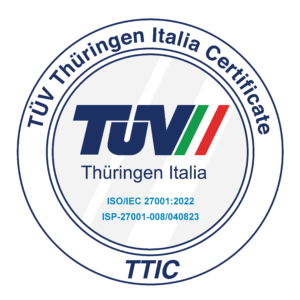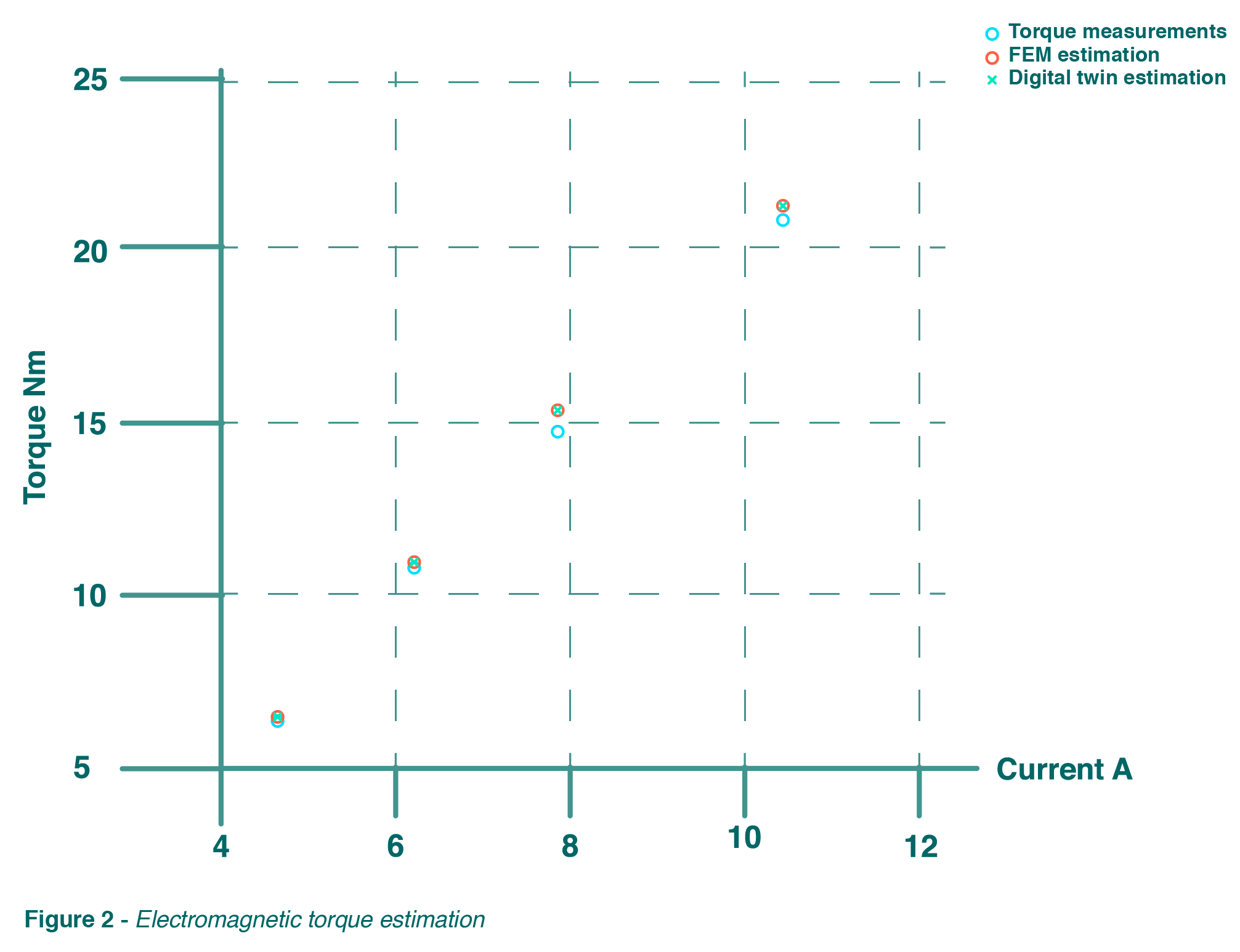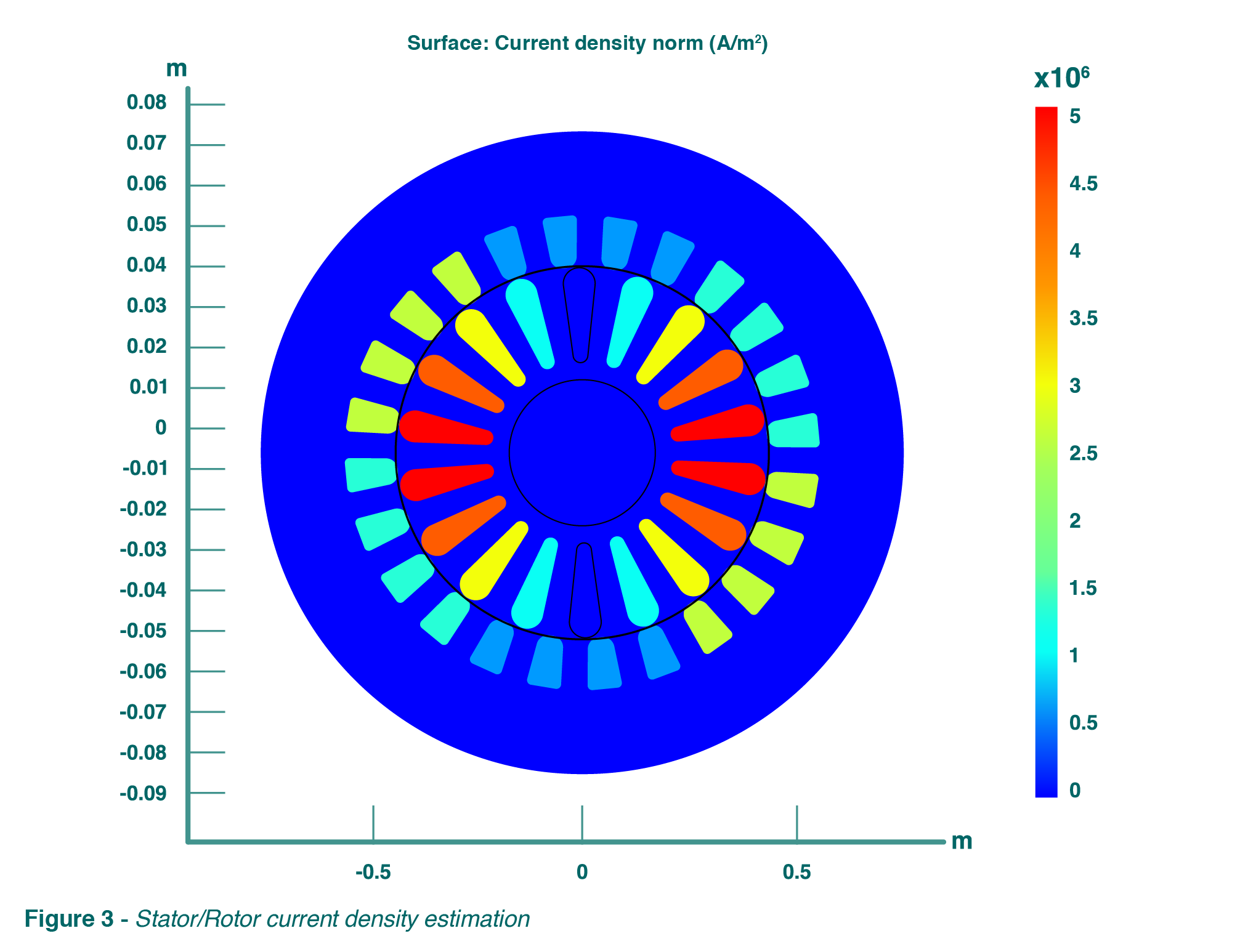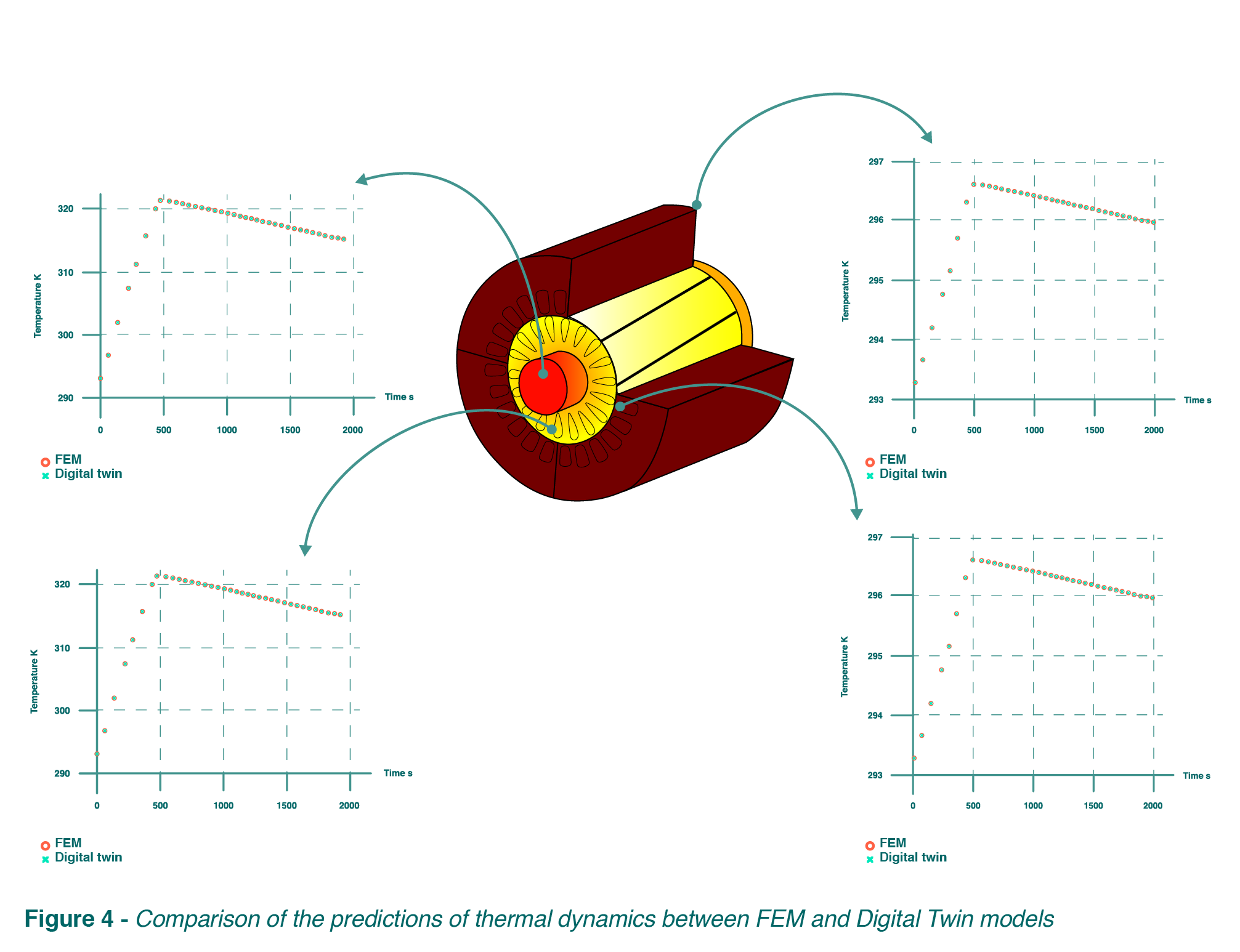White paper – Digital Twin Software for
Electrical Machines
Digital twins are real-time digital replicas of physical assets based on
predetermined mathematical models.
How can this technology solve general problems related to electrical machines in an industrial environment?
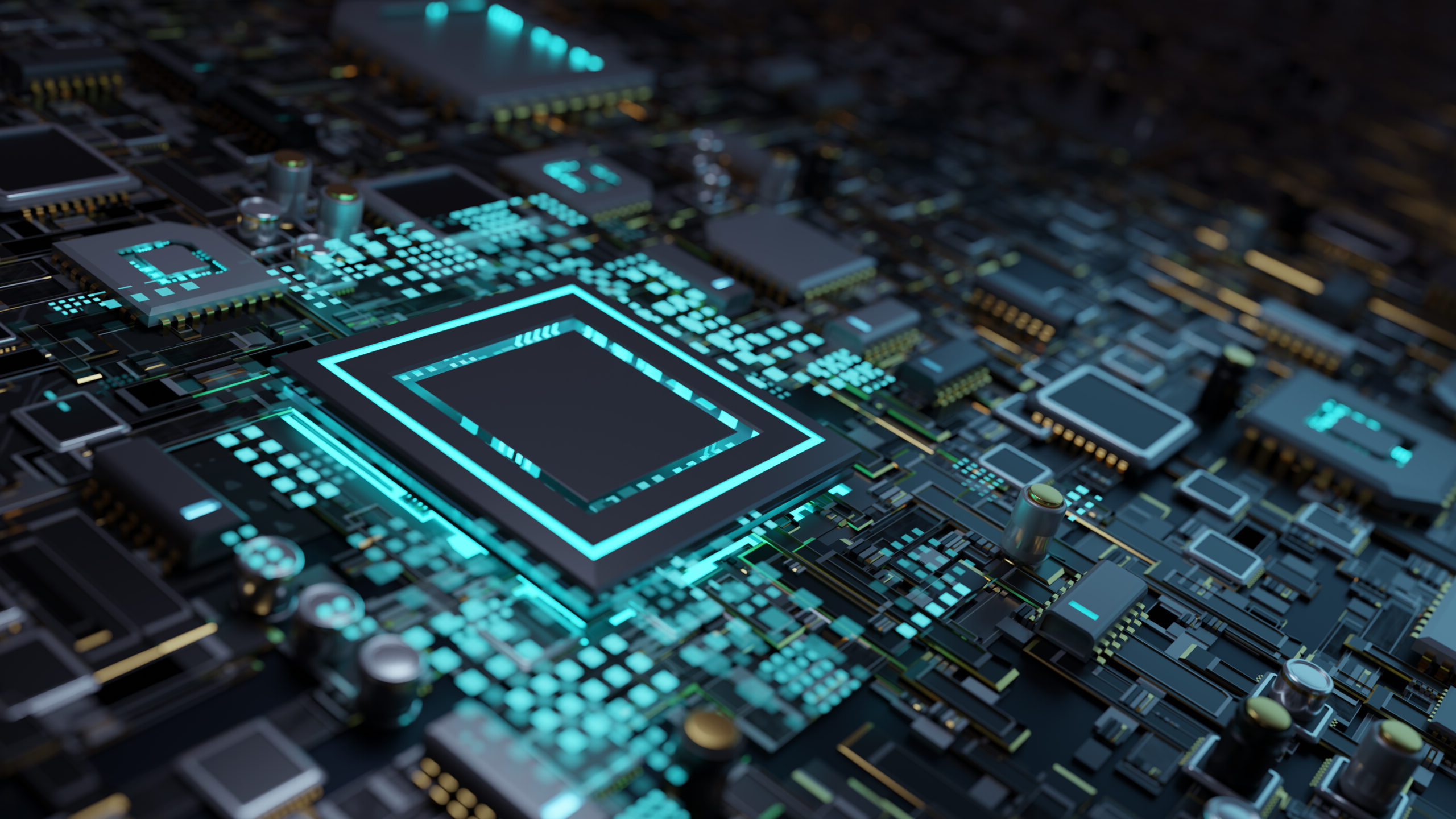
Digital Twin Software for Electrical Machines – 1. THE PROBLEM
The use of Electrical Machines (EMs) in any industrial application involves many critical aspects that must be addressed in order to ensure optimal operation and cost effectiveness. Hereafter are discussed some of the main issues, which we intend to solve with our digital twin technology.
Digital Twin Software for Electrical Machines – 1.1 Design
Designing an electrical machine is a complex multilevel task. The process takes into account several factors, including, among others, production technologies, quality standards, and economic indicators. Furthermore, the process is complicated by the multi-physical behavior of the system, thus requiring heterogeneous skills for obtaining the desired product. The main goal for an electrical machine designer is to find the shortest path from the initial idea to production and testing. In this process, the use of computationally heavy simulations is mandatory and the required time grows drastically with the complexity of the machine model. Thus, exploring many operating conditions through simulation significantly slows down the time-to-market and there is a clear need for speeding up this process.
Digital Twin Software for Electrical Machines – 1.2 Data Sheets
Most of the time, electric motor/generator manufacturers do not provide accurate enough data sheets. This is due to the fact that EMs have an extremely non-linear behavior, so the parameters that characterize them vary significantly depending on load conditions, such as voltage and current, and on external conditions, such as temperature. Obtaining this information requires a considerable testing effort, with the associated costs in terms of energy, instrumentation, and highly skilled personnel. However, the lack of an accurate characterization of the EM negatively affects the control, which needs parameters with minimum uncertainty to ensure maximum efficiency. Unfortunately, at present industrial drives for EM do not have an accurate parameterization of the machines they are controlling. Thus, it is likely that the system is not operating optimally, therefore wasting energy, using more time than needed to complete operations, and increasing the wear of machinery, thus reducing its lifetime. In other words, it is not convenient to design a highly efficient electrical motor/generator if it is not possible to control it efficiently as well. There is therefore a clear need for a solution capable of extracting EM datasheet information for increasing the overall system efficiency through knowledge-based controls, reducing user and developer costs, thus improving profitability.
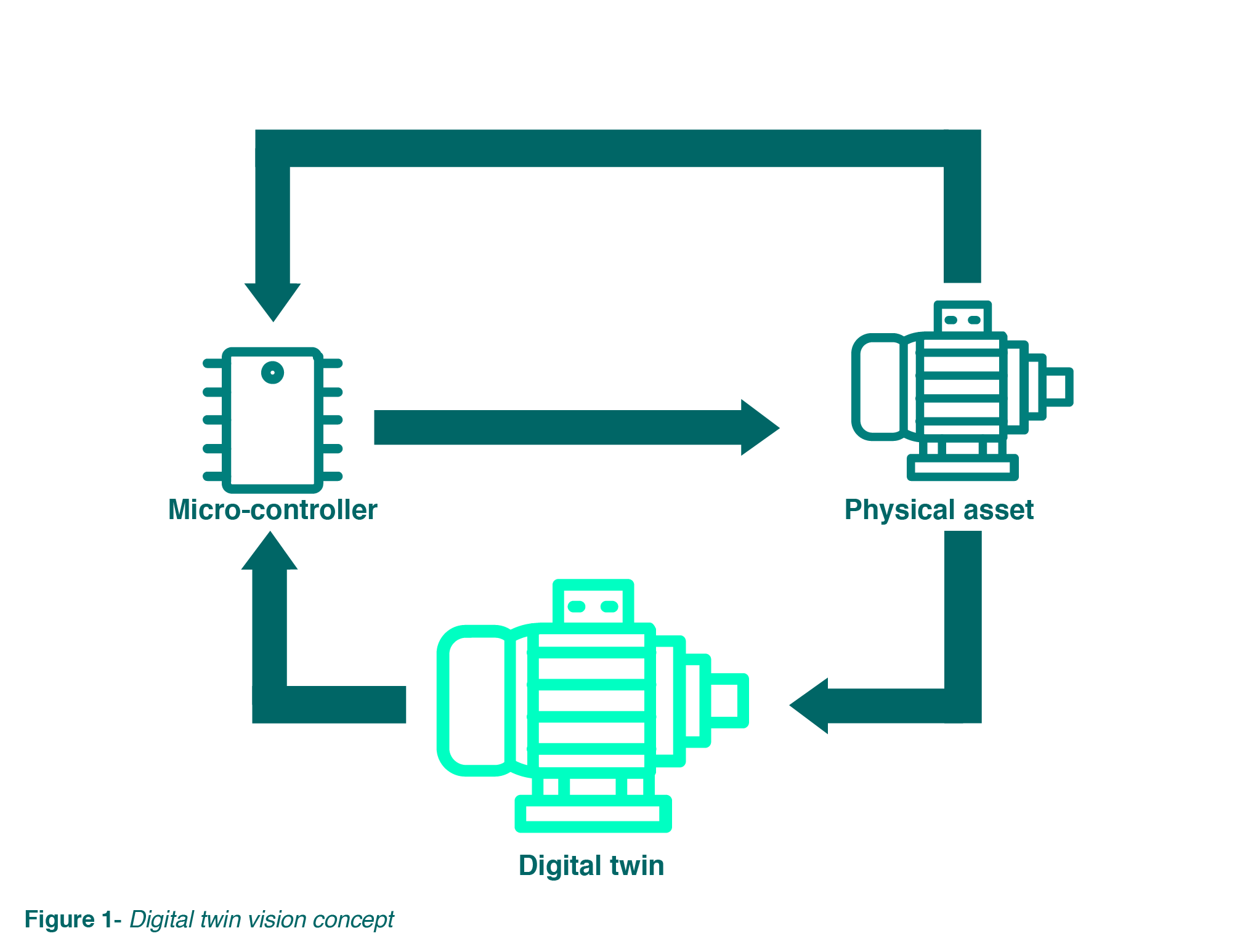
Digital Twin Software for Electrical Machines – 2. THE SOLUTION
In this section, we present our proposed solution to address all the challenges highlighted in the previous section. In particular, the main concepts of our technology are illustrated and all the features and benefits are described and analyzed.
Digital Twin Software for Electrical Machines – 2.1 Digital twin definition
Digital twins, also known as computational mega models, device shadows, mirror systems, avatars, or synchronized virtual prototypes can be defined as data-, knowledge- and simulation-based virtual representations of physical assets, to be used for real-time prediction, optimization, monitoring, control, and improved decision making. Recent advances in computational pipelines, multiphysics solvers, artificial intelligence, big data cybernetics, data processing, and management tools are bringing the promise of digital twins and their impact on society closer to reality. Digital twinning is now an important and emerging trend in several fields and there is no doubt that digital twins play a transformative role in the way we advance the modularity of multidisciplinary systems to address fundamental barriers not addressed by current evolutionary modeling practices, (Rasheed, San, and Kvamsdal, 2020).
Digital Twin Software for Electrical Machines – 2.2 Our technology
We present and explain the general framework we adopt for setting up a digital twin of an EM. Our approach consists in using highly accurate numerical and analytical models to create digital twins for model-based condition monitoring. The process of designing our digital twins consists of the following main steps.
•MODELLING: In most cases complex and accurate models used in the design phase of EMs are available. One of the most commonly used methods is Finite Element Method (FEM). It is used in many open-source and commercial multiphysics simulation environments (Sheikhi, 2011). These models are the starting point for the development of our digital twin. In fact, they have to be post-processed in order to be written in a particular
form, suitable for Model Order Reduction (MOR) techniques (Benner, Gugercin, and Willcox, 2015);
•MOR: The digital twin software has to run in parallel with the physical operation if it is designed for monitoring applications, and thus it must be real-time capable. With MOR-based techniques, it is possible to reduce the models while preserving the accuracy required by the application, (Hartmann, Herz, and Wever, 2018). Of course, we have to deal with a trade-off between computational complexity and model accuracy depending on the application, for example, whether we need to speed up EM design simulations, monitor EMs in real
time, or predict EM behavior;
•VIRTUAL SENSING: In our opinion, the main functionality of the digital twin is monitoring, and therefore the ability to describe EM behavior in real-time. Therefore, we consider the digital twin as a virtual sensor because it allows us to obtain the information regarding the EM behavior with high detail and precision, avoiding the need of implementing complex and expensive sensor technology and thus both achieving cost savings and more information at the same time. The ability of the digital twin to run as a virtual sensor is the most difficult test bed, as the software requires both model accuracy and real-time capability.
Digital Twin Software for Electrical Machines – 2.3 Features & Benefits
Below we describe the characteristics and advantages of digital twins that we propose to address the problems and needs described in the previous section.
As mentioned earlier, the MOR compromise between model accuracy and calculation cost is what characterizes the digital twin approach. In particular, during the design phase, testing many operating conditions in simulation is extremely time-consuming, and a digital twin design model designed for fast simulations in order to speed up testing represents an optimal solution. In this case, the trade-off between accuracy and time is tuned slightly in favor of the accuracy, since the considered is an off-line application and the reduced model must be accurate enough to describe the EM asset in detail. Of course, the digital twin designed for fast simulations will run faster than the original model, saving considerable time. Regarding the problem of the impossibility of providing a deep and complete technical data sheet of the parameters, our proposed solution is a digital twin able of providing in real time all the necessary control parameters. It will be possible to extract in real-time all the desired parameters relative to the EM, akin to having a massive Look Up Table (LUT) without the disadvantage of memory and LUT searching efforts. From control to safety, high-precision measurements and estimates are key information for many industrial EM applications. Unfortunately, most of the time they are expensive and inaccurate for many industrial applications. Our digital twin solution, designed to be a virtual sensor, can become a disruptive technology capable of providing massive data and information from the EM twin, thereby also reducing the number of sensors required for the application. So far we have shown the main features and advantages of the digital twin. However, the idea we have
of this technology is much more far-sighted. In fact, we intend to use digital twins as data collection tools and apply consolidated machine learning and artificial intelligence techniques to them in order to improve constructive data analysis for EM fault classification, EM online diagnosis, and EM predictive maintenance. Big Data, Iot, communication, and computational technologies are the enabling technologies for digital twin platforms in order to process the massive amount of data they collect during the EM life cycle.
Digital Twin Software for Electrical Machines – 3. THE PROOF OF CONCEPT
Our test bed consists of a digital twin capable of replicating the electromagnetic and thermal behavior of an Induction Motor (IM). In sequence, we started from a FEM model, we post-processed it, making it suitable for MOR, we developed the reduced order model, studying the right compromise in order to obtain real-time performance, we studied the accuracy of the reduced model, comparing it with the initial FEM model and the real prototype, and we verified the real-time implementation, discussing the possibility of using it as a virtual sensor.
Digital Twin Software for Electrical Machines – 3.1 Electromagnetic behavior
The proposed digital twin works as a digital replica of its IM twin. In particular, simply by measuring the three-phase stator currents, the digital twin can simulate the three-phase stator voltages, the induced rotor currents, the generated electromagnetic torque, and all the parameters necessary for Field Oriented Control (FOC), e.g. the slip frequency and the rotor resistance. Figs. 2 and 3 show, respectively, the torque estimation and the current density estimation of the IM. As far as the first one is concerned, we compared the electromagnetic torque estimations, obtained with both FEM and our twin digital software, with that of the IM prototype mounted on a test bench, measured by means of a torque meter. As can be observed, the estimate of the digital twin is equal to that of the FEM, which means that the reduced order model, obtained with MOR, has been well-designed. The measurement differs slightly from the estimates because the torque in the shaft is smaller due to mechanical losses. Fig. 3 shows the estimated current density of the IM. This was estimated at a certain time during a steady-state operating condition. Real-time torque and current estimates have multiple uses. With FEM it is impossible to obtain real-time predictions, instead, the adoption of our digital twin software allows for it while preserving the estimation accuracy of FEM, and thus having all the advantages mentioned in the previous section.
Digital Twin Software for Electrical Machines – 3.2 Thermal analysis
The thermal management of EMs is one of the main challenges facing the industry. High temperatures increase the probability of eÿciency problems, failures, and profit reduction. However, it is often not trivial to measure or even estimate the temperature of EMs in general. Below, we show how the digital twin can overcome this problem with a highly accurate temperature estimation of the IM under test, similar to having a thermal imaging camera that can estimate the temperature in real-time and also predict thermal dynamics, providing useful information for fault prevention. Fig. 4 shows the 3-D FEM model, where four temperature probes, two in the rotor and two in the stator, are implemented to study the thermal behavior of the IM. In particular, after 500 seconds, the machine is switched o˛ and starts to cool down. It is worth noting that the estimate of the digital twin is almost identical to the one obtained by FEM, and, thanks to its reduced order model, it can predict in a few seconds the thermal behavior of the IM over several hours of operating conditions. This feature has multiple advantages, for example, it is possible to predict the temperature of each individual rotor point and use this information to efficiently manage the cooling system, which is generally overused because the rotor temperature is unknown, but this drastically compromises the efficiency of the IM.
Digital Twin Software for Electrical Machines – 3.3 Real-time implementation
Real-time implementation capability is an important feature of our concept of digital twins. The table shows the calculation times for the execution of the FEM model and the Reduced Order Model (ROM), obtained with the MOR techniques. In addition, the numbers of Degrees of Freedom (DoF) of FEM and ROM are reported. As can be observed, with the digital twin we can simulate 2000 s of thermal behavior simply by solving a reduced model, which requires about 0.1 s to be solved, with a speed-up of over three orders of magnitude and without any loss of accuracy.
Digital Twin Software for Electrical Machines – 4. CONCLUSIONS
We have proposed three pillars that the industry should consider in order to exploit the full potential of digital twins:
• Virtual Twin: Creation of a virtual representation of a physical asset;
• Predictive Twin: Physics based, data based, or hybrid models to predict the behaviour of the phys-ical asset;
• Improved Twin: Data analysis to improve decision making and to build new models.
The launching of the Industry 4.0 program con-tributed to a momentum to in the adoption of the Digi-tal Twins, being one of the digital disruptive technology of the upcoming years. This technology has evolved from the simple virtualization into a complex digital copy of real assets, being characterized by the combi-nation of several technologies, such as optimization, real-time data and machine learning.
Bibliography:
Benner, Peter, Serkan Gugercin, and Karen Willcox (June 2015). “A Survey of Projection-Based Model Reduction Methods for Parametric Dynamical Systems”. In: SIAM Review 57, pp. 483–531. doi 10. 1137/130932715.
Hartmann, Dirk, Matthias Herz, and Utz Wever (2018). “Model Order Reduction a Key Technology for Digital Twins”.
Rasheed, Adil, Omer San, and Trond Kvamsdal (Jan. 2020). “Digital Twin: Values, Challenges, and Enablers from a Modeling Perspective”. In: IEEE Access PP, pp. 1–1. doi 10.1109/ACCESS.2020.2970143.
Sheikhi, M. Reza H. (2011). “Review of “Computational Fluid Dynamics, Second Edition”. In: AIAA Journal 49.7, pp. 1567–1567. doi: 10.2514/1.J051005.
Authors: Francesco Toso, Andrea Favato, Riccardo Torchio, Matteo Carbonieri, Milo De Soricellis, Piergiorgio Alotto and Silverio Bolognani
https://www.newtwen.com/aboutus
https://www.linkedin.com/company/newtwen/
